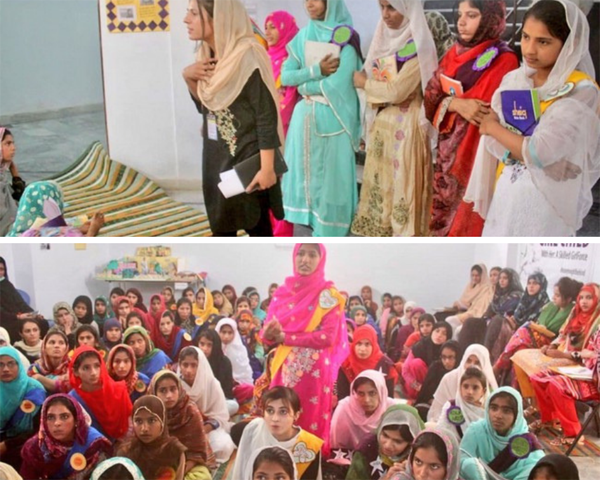In Search of Common Ground for Learning Indicators " From Local to Global" - Baela Raza Jamil
Baela Raza Jamil
CEO ITA – & Lead ASER Pakistan
Commissioner Education Commission
Member – Platform for Girls Education
For 10 consecutive days in October, I travelled across Hamburg, Germany; Karachi, Islamabad, Muzzafarabad (AJK), Rahim Yar Khan, Bahawalpur, Multan, Muzzaffargarh, and Lahore. The purposes of my travel included chasing a consensus for globally agreed learning indicators, initiating the 2018 Annual Status of Education Report (ASER) assessments, and overseeing accelerated learning gains for out-of-school adolescent girls. Mind boggling as the 10-day footprint may be, the common thread was the importance of measuring and improving learning, and that improvements are verified through agreed definitions.
Let us start with the international leg of my journey. Sustainable Development Goal (SDG) 4.1.1 reports learning at lower primary (2-3 grades), end of primary (5-6 grades) and lower secondary (8-9 grades). Imagine a consensus on these indicators for the world, where each country conducts its own national tests! This is precisely the challenge the global education community has been trying to unpack since 2015, when the SDGs were launched and endorsed globally. It has meant a diligent search for common ground with logical steps.
The journey of many partners to map and define learning for SDG 4 indicators began in 2015. The UNESCO Institute of Statistics (UIS), the custodian agency for SDG 4 indicators, convened over 200 experts, practitioners, CSOs, and member states establishing a Global Alliance to Monitor Learning (GAML). This includes representation from citizen-led assessments via the People’s Action for learning (PAL) Network. GAML is tasked with development of new indicators, methods, standards and statistical approaches to assess progress towards the SDGs, along with building capacity of member states as needed.
As part of GAML, the UIS has mobilized multiple partners across countries, expert agencies, regional and international assessment bodies. This has been a journey that included mapping curricula and learning levels across international and regional assessments and coming up with agreed definitions of “minimum proficiency” in mathematics and reading.
I returned to Pakistan to the work we have been doing to monitor basic reading and mathematics since 2009. Idara-e-Taleem-o-Aagahi (ITA) or the centre for education and consciousness, a national civil society organization in Pakistan works in research, policy and service delivery. ITA’s flagship program on mapping learning, the Annual Status of Education Report (ASER) Pakistan is a citizen-led nationwide assessment for 5-16 year olds across the country focused on SDG 4.1.1 a or grade 2 level competencies in language and numeracy (2009-2018). ASER’s principles are logical:
- keep it simple, using easy-to-comprehend tools accessible to all citizens,
- ensure, one-on-one assessment with the child, and
- maintain rigorous data regimes to provide a reliable insight to the status of children’s learning
Results of the ASER survey are available for each age group assessed, mainly reported at grades 3 and 5, but available for all other grades for children assessed up to 16 years of age.
What is clear from repeated citizen-led surveys by ASER Pakistan since 2009, is that our children may be in school, but they are not all learning what they are supposed to be at the grade 2/3 level, and this pattern continues on to grades 5 and higher! The children not learning are at risk for dropping out at subsequent levels in the schooling system. Adolescent girls from 9-19 years of age are particularly vulnerable in Pakistan.
This learning crisis among adolescent girls brought me to the final leg of my journey, the program recently launched by ITA, Siyani Sahelian (“wise friends”) or the Accelerated Action for Adolescent Girls (A3G) initiative. This was conceived as a second chance initiative for girls who had dropped out of school, which provides learning intervention and also transportation for some to access the learning hubs.
The target is to reach 22,000 girls in 3 districts of South Punjab, and of the 800 reached in the first few months of the initiative we see early signs of hope. The girls are learning literacy and numeracy themselves in self-directed learning activities. They are engaging in “mind maps” for making meaning of the text they read, creating stories; and understanding numbers and operations skills. Above all they love to learn together as friends, which reinforces their individual mastery of skills.
After four to eight weeks in the program, the Siyani Sahelian are expressing themselves and learning without fear. They make chalk drawings on the floor, use workbooks, and are gaining confidences with tablets for blended learning. They ask questions, help each other achieve milestones through daily learning routines, and now have the capacity to ask questions that they never would have previously, as they had been labelled within their family and society as ‘failed learners”.
As I asked the Siyani Sahelian questions about their names, ages and learning experiences, many would turn around to ask me, “And ma’am, and your name is? What do you do?” showing a level of confidence and communication that was previously dormant. Our wise friends ‘Bushra, Noreen and Tahira” are pursuing a variety of skills, including those measured by SDG 4.1.1(a, b and c), with indicators of success.
Tahira, Bushra and Noreen, after 2 months of an accelerated immersion program of teaching at the right level (TARL), have begun to reconnect with their textbooks for grades 5, 8, and 9. Some are already being registered for the examinations coming up in February 2019. Their spelling may not be right but the foundations for thinking and learning are in place. Some of our Siyani Sahelis may not know this, but their learning benchmarks achieved will be exactly the same their counterparts in any part of the world!
Now that is a powerful milestone worth arriving at; the travels after all are not in vain!

Source: This blog was also published by the UNESCO Institute for Statistics




